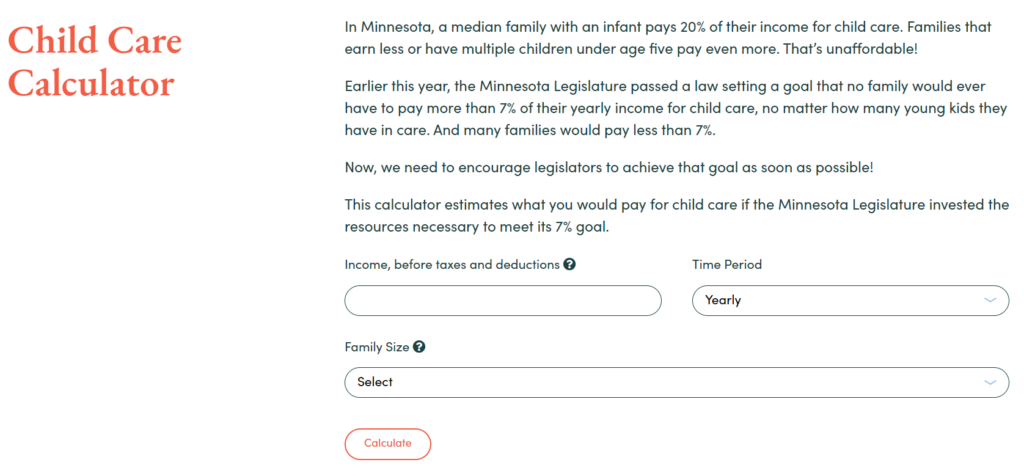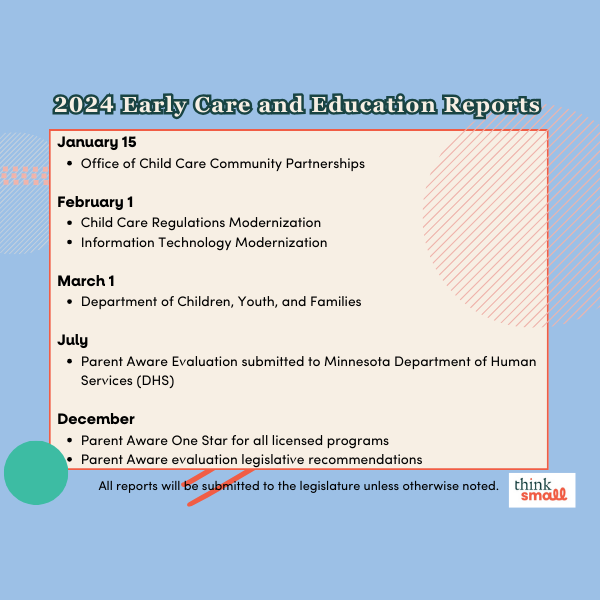There is broad agreement that Minnesota’s current early care and education system is not working well for parents, children, or providers. Costs for parents are too high to bear. The Great Start for All Minnesota Children Task Force Report addresses the multi-faceted challenges of the current early care and education system. It lays out a path forward to a system where all children have access to quality care, families can afford the care, and early childhood educators are fairly compensated. Think Small created a Child Care Calculator for families to estimate what they would pay for child care in a system where no family would ever have to pay more than 7% of their income toward child care. The Child Care Calculator specifically addresses the affordability for parents aspect, but it is situated within the work to address the other challenges also. The Minnesota State Legislature implemented some recommendations from the Great Start Report during the 2023 session, including setting a goal that no family ever has to pay more than 7% of their income toward child care costs. However, the legislature did not provide funding to reach the goal. The Child Care Calculator reflects what a system could look like where no family has to pay more than 7% of their income toward child care.
The Minnesota State Legislature implemented some recommendations from the Great Start Report during the 2023 session, including setting a goal that no family ever has to pay more than 7% of their income toward child care costs. However, the legislature did not provide funding to reach the goal. The Child Care Calculator reflects what a system could look like where no family has to pay more than 7% of their income toward child care.
How Would It Work for Child Care Providers?
The proposal is to use public funds as a bridge between what parents are expected to pay (the result you see at the calculator) and what providers need to operate quality programs and earn a living. In practice this would work in ways similar to the state’s existing Early Learning Scholarship program. Like Early Learning Scholarships, families would choose among a wide array of quality programs in their area (Licensed Family Child Care, Child Care Centers, Head Start, Public School), and the public share of funding for a particular child would follow them to their chosen program. Unlike the current Scholarship model, however, the vision is that providers would be paid in advance of a child’s attendance instead of after the fact. This is another change that the federal government is considering for child care assistance programs around the country. It’s something that other states, like our neighbor North Dakota, are already doing. The state of Minnesota also experimented with this approach in the summer of 2021 with a “summer preschool program” where money went to all types of providers and was paid in advance of services being provided.
Where Does 7% Come From?
You may be familiar with the guidance that families should not spend more than 30% of their income on housing. This is a similar concept. Officials in the federal government analyzed family budgets and necessary expenses and determined that child care is “affordable” when it takes up no more than 7% of a family’s budget. That 7% affordability standard has been promoted under the Trump and Biden administrations. Right now, the federal government is revising the rules for the grants that fund state child care assistance programs and is widely expected to adopt that 7% standard for maximum co-payments. For the most part, these are recommendations and proposals. There’s still time to shape the policies and details as we learn more. The calculator and larger discussion about child care affordability is a way to work toward an early care and learning system that works well for children, providers, and parents. By Ericca Maas







